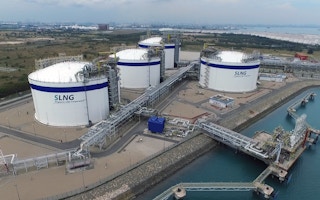Singapore’s second liquefied natural gas (LNG) terminal, targeted to be operational before 2030, will “not run a significant risk of asset stranding”, a minister has said.
To continue reading, subscribe to Eco‑Business.
There's something for everyone. We offer a range of subscription plans.
- Access our stories and receive our Insights Weekly newsletter with the free EB Member plan.
- Unlock unlimited access to our content and archive with EB Circle.
- Publish your content with EB Premium.
This is given the city-state’s higher future electricity demand and the current immaturity of alternative clean power sources, he added.
Second minister for trade and industry Tan See Leng was replying to a question in parliament on Friday, during a session debating Singapore’s national budget. A fellow ruling party lawmaker had asked how the terminal fits with Singapore’s green energy plans.
LNG critics have said new gas infrastructure risks premature write-downs with the rise of cleaner solar and wind power, and strong regulations against carbon emissions. Sky-high global gas prices in 2021 and 2022 due to the post-pandemic economic bounceback and Russia’s invasion of Ukraine also caused financial losses in many gas-reliant Asian countries.
“When we did the projections, [they showed that] with the increase in our [electricity] consumption, the second LNG terminal would not run a significant risk of asset stranding, even if we were to completely transition into all-renewable energy, which is unlikely to be the case,” Tan said. Singapore currently depends on natural gas for some 95 per cent of its power generation.
The minister said natural gas will remain needed for energy security as new low-carbon energy sources, such as renewable hydrogen, geothermal and nuclear energy, are still unproven. Singapore wants to import 4 gigawatts of clean electricity from neighbouring countries by 2035, but that will only cover under a third of the supply needed that year. Domestic solar is expected to cover 3 per cent of needs in 2030.
“For us, energy security, reliability and our resilience is of utmost importance,” Tan said.
Singapore’s first LNG terminal, which stores supercooled liquefied natural gas brought in by tanker ships, has a peak capacity of 11 million tonnes per annum (mtpa) and was completed in 2013. It currently provides for half of the country’s gas power generation needs, but if needed can fully take over the rest of the supply piped in from Indonesia and Malaysia.
The city-state’s gas consumption is expected to increase in the coming years, and retaining the 100 per cent LNG supply capability has been cited as an impetus for a new 5mtpa terminal. Green light for construction was given last October.
LNG terminals are generally expected to last two to three decades, though many units worldwide have demonstrated longer lifespans. Singapore is eyeing net-zero power generation by 2050. Its energy market regulator, in a 2022 scenario planning paper, has suggested that the city-state can largely stay off natural gas by then through scaling up the use of hydrogen and power imports.
On Friday, Tan announced that Singapore will award around S$43 million (US$32 million) to six research projects around deploying hydrogen fuels, in areas such as energy efficiency, durability and safety. Another S$12 million (US$9 million) will support studies into remote concepts such as “energy harvesting”, where pockets of energy in the environment – vibrations, waste heat or human movements – are converted into electric power.
Few additional details were provided for the Future Energy Fund announced last month, beyond that project types could include hydrogen, and that there could be future top-ups of the fund. Singapore’s deputy prime minister and finance minister Lawrence Wong had shared plans to set up the fund, which will have an initial injection of S$5 million (US$3.7 million), in his annual budget statement. He said this will help build the critical infrastructure needed for Singapore’s shift to low-carbon electricity.
The government also signed an agreement with oil majors Shell and ExxonMobil to develop a cross-border carbon capture and storage project that can handle at least 2.5 million tonnes of carbon dioxide per year by 2030.
There was no mention of destination countries for any emissions captured, though last month Indonesia and Singapore agreed to work on transporting and storing carbon dioxide. Indonesia has many submarine oil fields that can be used as deposit sites.
Tan said the government will do its “utmost best to calibrate the trajectory of our energy transition and its impact on electricity tariffs”. Singapore’s household utility bills are set to rise this year as the carbon tax is raised from S$5 (US$3.70) to S$25 (US$18.60) per tonne of emissions.
“Rest assured that the government will take great care in charting our energy transition, to ensure that even as we decarbonise, we maintain our energy security and we will remain cost-competitive,” he added.










